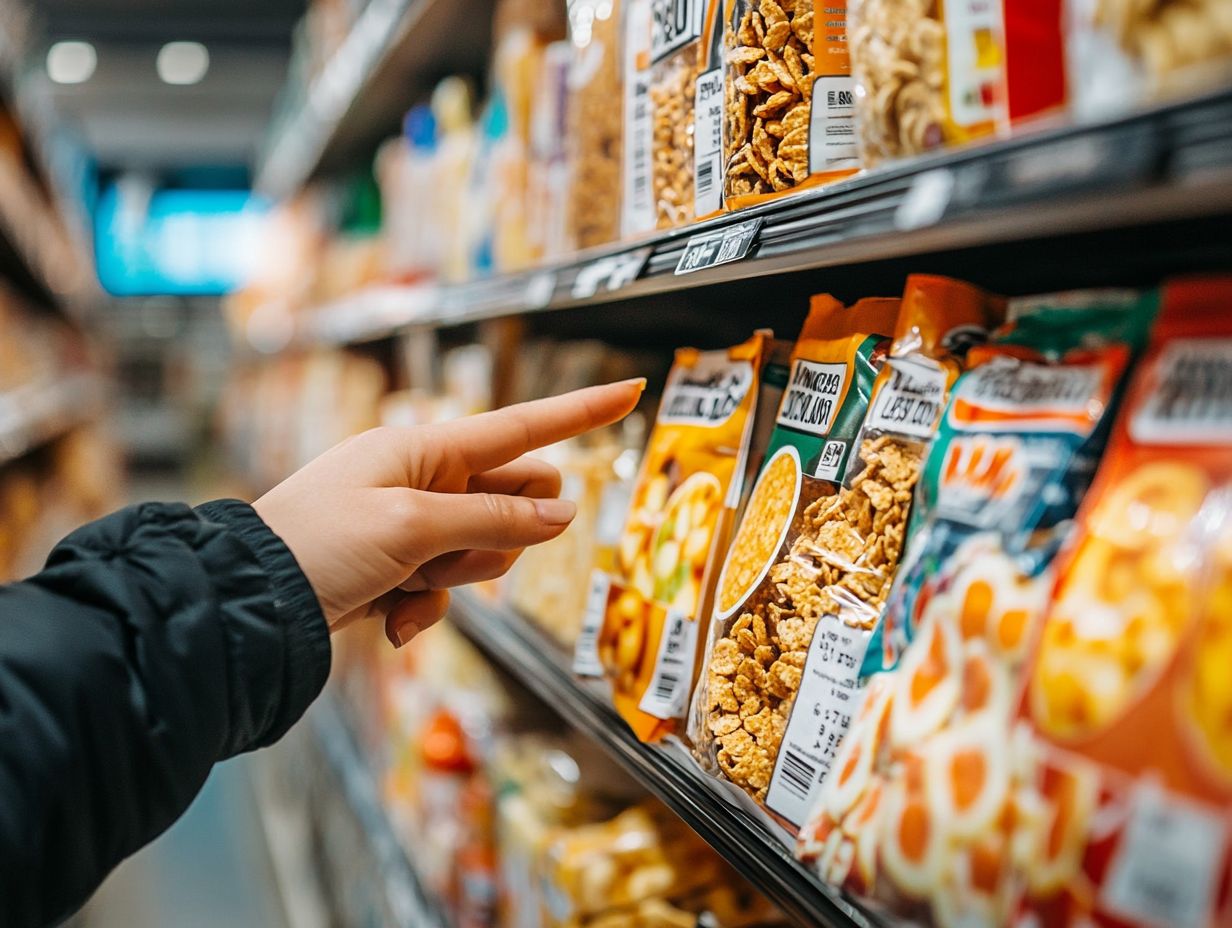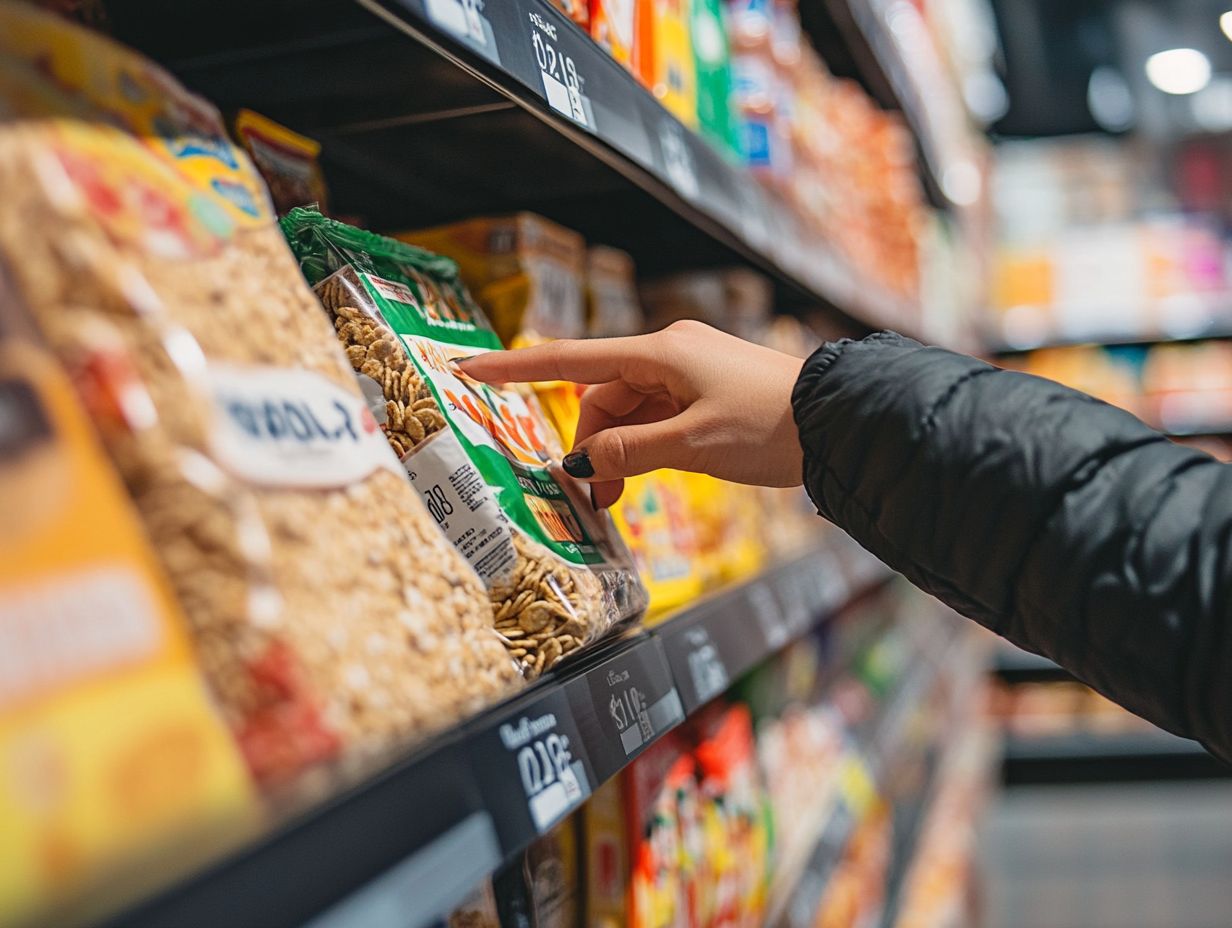How Do I Read Food Labels Effectively?
Navigating food labels can seem daunting. However, mastering them is essential for making informed choices about your diet.
This article simplifies the crucial elements of food labels. We ll cover nutritional information, ingredient lists, serving sizes, and those sneaky hidden ingredients.
Whether you follow a specific diet, like vegan or gluten-free, you’ll find valuable tips to enhance your label-reading skills.
With this guide, you ll discover how to confidently select nutrient-rich foods that fuel your body!
Contents
Key Takeaways:

Pay attention to the key components of food labels, including the nutritional information and ingredients list, to make informed decisions about what you consume.
Learn to interpret serving sizes accurately to track your intake and avoid consuming excess calories and nutrients.
Be aware of hidden ingredients commonly found in processed foods. Keep an eye out for specific components that may not align with your dietary needs.
Understanding Food Labels
Understanding food labels is crucial for health-conscious individuals like you. It helps you make informed decisions about nutrient intake, manage chronic disease risks, and enhance overall dietary quality.
Governed by FDA guidelines, these labels provide essential insights, including nutrition information, serving sizes, and health claims.
By focusing on this information, you can confidently choose nutrient-dense foods while steering clear of processed items and deceptive labels.
What Information is Included?
Food labels are a goldmine of information, featuring nutrition information that outlines serving sizes, total calories, daily values, and ingredient lists highlighting potential allergens.
Understanding serving sizes is crucial, as they dictate the nutritional values that follow. This makes it easier to manage your caloric intake effectively. The total calories listed per serving provide insight into your energy consumption an essential factor in maintaining a balanced diet.
By paying attention to daily values, which indicate how much of a nutrient is in a serving compared to the daily recommended intake, you can better identify how much of certain nutrients to aim for each day.
The ingredient list is equally significant, especially if you have food allergies or sensitivities, as it details every component in the product. This transparency allows you to make informed choices and ensure safer consumption.
Key Components of Food Labels
The key components of food labels are vital for making informed dietary choices.
The nutrition information panel provides essential insights, highlighting added sugars, saturated fats, dietary fiber, and a range of vitamins and minerals. This information plays a significant role in understanding overall nutritional quality and its impact on health outcomes.
Nutritional Information

The nutrition information section of food labels offers essential insights into total calories, added sugars, saturated fat, and dietary fiber content. These factors can profoundly influence your dietary choices.
For example, being aware of saturated and trans fats enables you to choose heart-healthy options. These unhealthy fats often lurk in processed foods.
Recognizing misleading labels like those that tout being ‘low-fat’ yet are packed with added sugars helps you uncover the true nutritional value of products.
Keeping an eye on sodium levels is crucial for maintaining optimal blood pressure, especially for those at risk of hypertension. Ultimately, equipping yourself with this knowledge fosters healthier eating habits and guides you toward a balanced diet.
Ingredients List
The ingredients list is a vital element of food labels. It provides clarity on what s actually in the product and serves as an invaluable resource for those with food allergies, sensitivities, or preferences for organic over processed foods.
By looking closely at the order of ingredients, you can gauge the relative quantity of each component. They are listed from highest to lowest concentration, revealing the presence and significance of certain beneficial or harmful ingredients.
If you re health-conscious, it s crucial to keep an eye on chemical additives and preservatives. Many can trigger adverse reactions or lead to long-term health issues. Identifying potential allergens in those often extensive lists is essential for anyone with sensitivities.
This knowledge enables you to make informed choices that align with your dietary requirements and personal health aspirations.
Interpreting Serving Sizes
Understanding serving sizes on nutrition labels is essential for grasping how calorie counts and recommended daily intake levels for nutrients translate into practical dietary choices.
For health-conscious consumers like you, this information helps manage nutrient intake effectively and make informed decisions that align with your wellness goals.
How to Determine Serving Sizes
To determine serving sizes, compare the serving size on nutrition labels with your individual dietary guidelines. This alignment helps ensure that your calorie intake matches your nutritional needs and health objectives.
You can use common household items as handy references. For example, a cup of cooked rice is about the size of a tennis ball, while a proper serving of meat should be about the size of a deck of cards.
Familiarizing yourself with these practical measurements helps you sidestep the common traps of over-serving, especially with calorie-dense foods like nuts or dressings, where just a small amount can dramatically affect your daily intake.
Mindful serving sizes help you take control of your portions and boost your health journey!
Identifying Hidden Ingredients

Identifying hidden ingredients in processed foods is essential for you as a health-conscious consumer, especially if you have food sensitivities or allergies.
Many misleading labels can conceal potentially harmful components. Therefore, it s crucial for you to scrutinize what you eat.
Common Ingredients to Watch Out For
When examining food labels, keep an eye out for certain ingredients that signal unhealthy choices, such as elevated sodium levels, trans fats, and additives associated with food allergies.
Ingredients like high-fructose corn syrup and artificial colorings can heighten the risk of metabolic disorders and hyperactivity in children. Eating too many saturated fats can lead to heart disease.
To navigate these concerns, prioritize products with shorter ingredient lists. Lean towards whole foods like fruits, vegetables, and lean proteins, which typically contain fewer artificial additives.
By choosing items with natural and recognizable ingredients, you can significantly elevate your dietary choices. This ultimately promotes better long-term health outcomes and reduces the likelihood of chronic diseases.
Reading Food Labels for Specific Dietary Needs
Reading food labels effectively is essential for you, especially if you have specific dietary needs like a vegan or gluten-free diet.
Staying vigilant in your quest for accurate health information allows you to avoid potential allergens and ensure that your nutrition remains balanced.
Tips for Different Diets (Vegan, Gluten-Free, etc.)
For health-conscious individuals following specific diets like vegan or gluten-free, understanding food labels is essential. Nutrition experts highlight the importance of identifying key indicators that align with your dietary needs.
Navigating various dietary requirements goes beyond simply scanning for familiar terms. It demands a discerning eye for detail and an awareness of hidden ingredients.
When you examine labels, prioritize official labels like the Certified Vegan logo or the Gluten-Free Certification Organization mark. These show that rigorous standards have been met.
Familiarize yourself with common allergens and additives that might be present in products that seem safe. Stay informed through trustworthy health sources and consult qualified nutrition experts to make choices that genuinely suit your unique dietary lifestyle.
Frequently Asked Questions

How Do I Read Food Labels Effectively?
Reading food labels effectively is crucial for making informed decisions about what we consume. For guidance, check out this resource on how to read nutrition labels effectively. Here are some common questions regarding how to read food labels.
Why is it important to read food labels?
Food labels provide vital information about the nutritional content of what we eat. They help us make healthier choices and avoid items that may be harmful to our health.
Where can I find food labels?
Food labels are usually located on the back or side of food packaging. They may also be available online for certain products.
What information should I look for on a food label?
When reading food labels, focus on serving size, calories, fat, sodium, and other nutrients. To better understand these details, consider learning how to recognize nutritional labels. Check the ingredients list for any potential allergens or harmful additives.
How can I understand the information on a food label?
Food labels can be confusing, but remember a few key points. Pay attention to serving sizes, as they might differ from what you typically eat. To better understand food labels, you can explore how to read nutrition information and look for the percent daily value (%DV) to determine if a food is high or low in a specific nutrient. Always read the ingredients list to know exactly what is in your food.
What are some red flags to look for on food labels?
Watch out for added sugars, sodium, and unhealthy fats. Consuming these in excess can negatively affect our health.
Ready to take control of your diet? Start reading those labels today!






